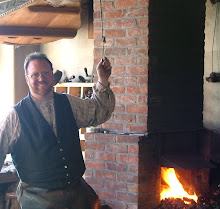Hundreds of fourth grade boys come to the blacksmith shop each year and many of them ask if we make swords. After their initial disappointment I try to lure them into a discussion of the farmers’ scythe. A well-made scythe blade is lighter, sharper, and harder to forge than a sword. A sword may never be called upon to make a crucial cutting stroke, while every stroke of the scythe is important to the farmer. A farmer in the 1840s may have carried his scythe in the field for several weeks each year, swinging its razor edge through hay, rye, barley, oats, and wheat. From before dawn until dusk the strokes of the scythe harvesting fodder and grain put security in the barn and money in the bank. 
 (whetstone for sharpening a scythe blade)
(whetstone for sharpening a scythe blade)
 At the farm, the scythe has been used to mow hay and reap rye, barley, oats, and wheat. A second crop of buckwheat is growing now and will be mown in September. These grains formed the foundation for daily life in the 19th century. Barley brewed your beer, buckwheat pancake broke your morning fast. Wheat and rye made your bread. This just shows that the old adage is true, you reap what you sow.
At the farm, the scythe has been used to mow hay and reap rye, barley, oats, and wheat. A second crop of buckwheat is growing now and will be mown in September. These grains formed the foundation for daily life in the 19th century. Barley brewed your beer, buckwheat pancake broke your morning fast. Wheat and rye made your bread. This just shows that the old adage is true, you reap what you sow.

 (whetstone for sharpening a scythe blade)
(whetstone for sharpening a scythe blade)Day-long use of a scythe is demanding work. It is not particularly hard to swing the scythe once. But a farmer reaping (another word for cutting) in midsummer may easily make 30,000 strokes with the scythe. To do that you must use more than your arms. The reaper’s whole body twists with each stroke, coiling and uncoiling from shoulders to waist. Harvesting day after day requires a reaper to become as efficient with the blade and snathe (handles and shaft of the scythe) as an Olympic swimmer is with his stroke. Each stroke, breath, and step is a synchronized movement. No motion is wasted.

 The Lippit Farmstead has grown a prize crop of grains this year. Here is a picture of their Wheat and Oats, which won 1st prize in the Otsego County Fair.
The Lippit Farmstead has grown a prize crop of grains this year. Here is a picture of their Wheat and Oats, which won 1st prize in the Otsego County Fair.

 The Lippit Farmstead has grown a prize crop of grains this year. Here is a picture of their Wheat and Oats, which won 1st prize in the Otsego County Fair.
The Lippit Farmstead has grown a prize crop of grains this year. Here is a picture of their Wheat and Oats, which won 1st prize in the Otsego County Fair.  At the farm, the scythe has been used to mow hay and reap rye, barley, oats, and wheat. A second crop of buckwheat is growing now and will be mown in September. These grains formed the foundation for daily life in the 19th century. Barley brewed your beer, buckwheat pancake broke your morning fast. Wheat and rye made your bread. This just shows that the old adage is true, you reap what you sow.
At the farm, the scythe has been used to mow hay and reap rye, barley, oats, and wheat. A second crop of buckwheat is growing now and will be mown in September. These grains formed the foundation for daily life in the 19th century. Barley brewed your beer, buckwheat pancake broke your morning fast. Wheat and rye made your bread. This just shows that the old adage is true, you reap what you sow.
I've heard that a scythe was also sharpened using a small hammer and anvil, as constant honing with a whetstone ultimately removes too much metal. Is there any truth to this?
ReplyDeleteMatthew,
ReplyDeleteThat's right. The method is called "peening", and can be done with a hammer and anvil or with a special small anvil and hammer. German farmers call the little anvil a "denglestock". I will be doing a blog about that in about a week. Peening restores the edge without removing metal and makes the edge harder. I suspect honing was used for quick resharpening and peening for more serious repair. Great question!
This comment has been removed by the author.
ReplyDeleteAre there many different sizes of scythes?
ReplyDeleteBy the way, this is Jacob. Because I'm using my google account, my name shows up as "Bob Smith". Sorry about the trouble.
ReplyDeleteJacob,
ReplyDeleteGood questions! There are several standard length scythe blades. Long "grass blades" are for cutting hay and grains. Ditch blades are several inches shorter and can cut thick and woody weeds. Brush blades are the shortest, and are for clearing thick weeds and brush at the edge of fields and hedgerows.
Is the scythe seen in the pictures a long scythe?
ReplyDeleteThe scythe in these pictures is an American Pattern with a long grass blade. Most of the old scythes in the U.S. are this pattern. The Farmers also use European Scythes, which we will show in a future blog. They are an even older style of blade, and are still made.
ReplyDelete